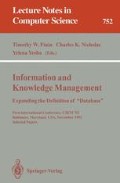Abstract
While significant effort is expended in developing a conceptual model for an information system, critical knowledge is discarded during implementation. Consequently, designers and users must employ less complete logical level knowledge to access data. Unfortunately, many users do not possess the detailed logical level knowledge required to formulate queries corresponding to ad hoc requests. By using the conceptual schema directly, however, it is possible to formulate such queries automatically. This paper describes how to augment the conceptual schema with knowledge of strongly associated conceptual level objects so that automated query formulation, semantic query optimization, and design feedback are supported. As a result, the conceptual schema assumes a central role throughout an information system's life cycle, and the design of intelligent interfaces is facilitated.
Preview
Unable to display preview. Download preview PDF.
References
C. Batini, B. Ceri, S. B. Navathe: Conceptual Database Design: An Entity-Relationship Approach. Redwood City, CA: Benjamin/Cummings 1992
P. P. Chen: The Entity-Relationship Model — Toward a Unified View of Data. ACM Transactions on Database Systems 1:1, 9–36 (1976)
R. Elmasri, S. B. Navathe: Fundamentals of Database Systems. Reading, MA: Addison-Wesley 1989
Ford Aerospace Corporation: Appendix B to User's Guide for the Space Telescope Data Archive and Distribution Service (ST DADS) CDR Version. Ford Aerospace Corporation Space Programs Operation, October 1990
R. Hull, R. King: Semantic Database Modeling: Survey, Applications, and Research Issues. ACM Computing Surveys 19:3, 201–260 (1987)
M. Jarke, J. Koch: Query Optimization in Database Systems. ACM Computing Surveys 16:2, 111–152 (1984)
J. J. King: QUIST: A System for Semantic Query Optimization in Relational Databases. In: Proceedings of the 7th International Conference on Very Large Data Bases, 1981, pp. 510–517
H. F. Korth, G. M. Kuper, J. Feigenbaum, A. Van Gelder, J. D. Ullman: System/U: A Database System Based on the Universal Relation Assumption. ACM Transactions on Database Systems 9:3, 331–347 (1984)
H. F. Korth, A. Silberschatz: Database System Concepts, 2nd ed. New York: McGraw-Hill 1991
D. Maier, J. D. Ullman: Maximal Objects and the Semantics of Universal Relation Databases. ACM Transactions on Database Systems 8:1, 1–14 (1983)
D. Maier, J. D. Ullman, M. Y. Vardi: On the Foundations of the Universal Relation Model. ACM Transactions on Database Systems 9:2, 283–308 (1984)
J. Mylopoulos, H. J. Levesque: An Overview of Knowledge Representation. In: M. L. Brodie, J. Mylopoulos, J. W. Schmidt (eds.): On Conceptual Modelling: Perspectives from Artificial Intelligence, Databases, and Programming Languages. New York: Springer-Verlag 1984, pp. 3–17
R. D. Semmel: A Knowledge-Based Approach to Automated Query Formulation. Ph.D. Dissertation. Baltimore: University of Maryland 1991
R. D. Semmel: A Knowledge-Based System for Automated Query Formulation. In: Proceedings of the Fifth Florida Artificial Intelligence Research Symposium, 1992, pp. 80–84
S. T. Shenoy, Z. M. Ozsoyoglu: A System for Semantic Query Optimization. In: Proceedings 1987 ACM SIGMOD International Conference on Management of Data, 1987, pp. 181–195
J. M. Smith, D. C. P. Smith: Database Abstractions: Aggregation and Generalization. ACM Transactions on Database Systems 2:2, 105–133 (1977)
T. J. Teory, D. Yang, J. P. Fry: A Logical Design Methodology for Relational Databases Using the Extended Entity-Relationship Model. ACM Computing Surveys 18:2, 197–222 (1986)
J. D. Ullman: Universal Relation Interfaces for Database Systems. In: Proceedings of the IFIP 9th World Computer Congress, 1983, pp. 243–252
J. D. Ullman: Principles of Database and Knowledge-Base Systems, Vol. 2. Rockville, MD: Computer Science Press 1989
Author information
Authors and Affiliations
Editor information
Rights and permissions
Copyright information
© 1993 Springer-Verlag Berlin Heidelberg
About this paper
Cite this paper
Semmel, R.D. (1993). Discovering context in a conceptual schema. In: Finin, T.W., Nicholas, C.K., Yesha, Y. (eds) Information and Knowledge Management Expanding the Definition of “Database”. CIKM 1992. Lecture Notes in Computer Science, vol 752. Springer, Berlin, Heidelberg. https://doi.org/10.1007/3-540-57419-0_1
Download citation
DOI: https://doi.org/10.1007/3-540-57419-0_1
Published:
Publisher Name: Springer, Berlin, Heidelberg
Print ISBN: 978-3-540-57419-4
Online ISBN: 978-3-540-48148-5
eBook Packages: Springer Book Archive

